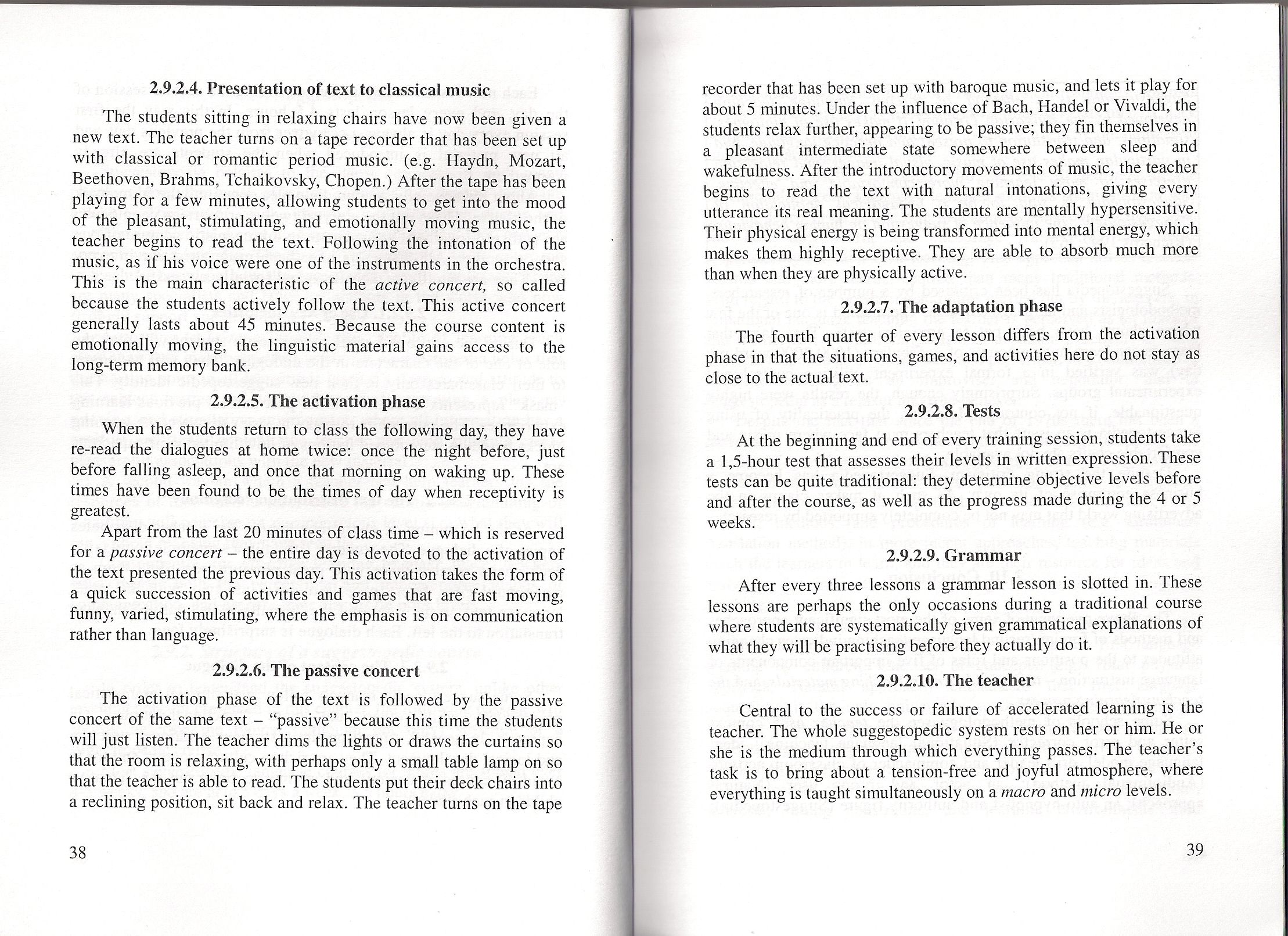68488 skanowanie0019 (32)

2.9.2.4. Presentation of text to classical musie
The students sitting in relaxing chairs have now been given a new text. The teacher tums on a tape recorder that has been set up with classical or romantic period musie. (e.g. Haydn, Mozart, Beethoven, Brahms, Tchaikovsky, Chopen.) After the tape has been playing for a few minutes, allowing students to get into the mood of the pleasant, stimulating, and emotionally moving musie, the teacher begins to read the text. Following the intonation of the musie, as if his voice were one of the instruments in the orchestra. This is the main characteristic of the active 'concert, so called because the students actively follow the text. This active concert generally lasts about 45 minutes. Because the course content is emotionally moving, the linguistic materiał gains access to the long-term memory bank.
2.9.2.5. The actiyation phase
When the students return to class the following day, they have re-read the dialogues at home twice: once the night before, just before falling asleep, and once that moming on waking up. These times have been found to be the times of day when receptivity is greatest.
Apart from the last 20 minutes of class time - which is reserved for a passive concert — the entire day is devoted to the activation of the text presented the previous day. This activation takes the form of a quick succession of activities and games that are fast moving, funny, varied, stimulating, where the emphasis is on communication rather than language.
2.9.2.6. The passive concert
The activation phase of the text is followed by the passive concert of the same text - “passive” because this time the students will just listen. The teacher dims the lights or draws the curtains so that the room is relaxing, with perhaps only a smali table lamp on so that the teacher is able to read. The students put their deck chairs into a reclining position, sit back and relax. The teacher tums on the tape recorder that has been set up with baroąue musie, and lets it play for about 5 minutes. Under the influence of Bach, Handel or Vivaldi, the students relax further, appearing to be passive; they fm themselves in a pleasant intermediate State somewhere between sleep and wakefulness. After the introductory movements of musie, the teacher begins to read the text with natural intonations, giving every utterance its real meaning. The students are mentally hypersensitive. Their physical energy is being transformed into mental energy, which makes them highly receptive. They are able to absorb much morę than when they are physically active.
2.92.1. The adaptation phase
The fourth ąuarter of every lesson differs from the activation phase in that the situations, games, and activities here do not stay as close to the actual text.
2.9.2.8. Tests
At the beginning and end of every training session, students take a 1,5-hour test that assesses their levels in written expression. These tests can be quite traditional: they determine objective levels before and after the course, as well as the progress madę during the 4 or 5 weeks.
2.92.9. Grammar
After every three lessons a grammar lesson is slotted in. These lessons are perhaps the only occasions during a traditional course where students are systematically given grammatical explanations of what they will be practising before they actually do it.
2.9.2.10. The teacher
Central to the success or failure of accelerated learning is the teacher. The whole suggestopedic system rests on her or him. He or she is the medium through which everything passes. The teacher’s task is to bring about a tension-free and joyful atmosphere, where everything is taught simultaneously on a macro andmicro levels.
39
Wyszukiwarka
Podobne podstrony:
skanowanie0007 (3) Figurę 3-1. Summary of approach to laboratory investigation ofpleural fluids. LD,
carving?ce2 32 Rangę of Expressions These studies show a grinning face carved in wal-nut, Fig. 65, a
Certificate of CompletionPresented to: NameFor completing the Cisco Networking Academy® Introduction
3. What problem(s) do you think the people living in each house have to face? błock of flats: noisy
per cent of the hijras living in India today have undergone genital surgery - according to the 1990
NameDescription ?B_NBANKS number of banks to be supported. The following values are allowed: 2, 4,
To?sire a?vil USA Today bcstsclling author of ^ To Beguile a Beast A The Finał Book in The Lege
Fig. XII.3.11. A generał scheme for the oxi-dation of ammonia to nitrite by the enzymes, A MO and&nb
studiobox postopt STUDIOBOX POST OPTIONSHighlighted text Highlight text to display after the TitleIm
in 1981.4 A lotai of 381 cases have now been documented in Canada (Laboratory Centre for Diseas
497 on SWB. The analysis was conducted with the application of an ordered logit model. The dala used
SC spring 11013 CC( 1U1 U v-v r iócCctti God cares for birds of every color and variety—from the ch
UNIYERSITY OF CALIFORNIA Los Angeles Musie Circulation and Transmission in Tbilisi, Georgia A disser
więcej podobnych podstron